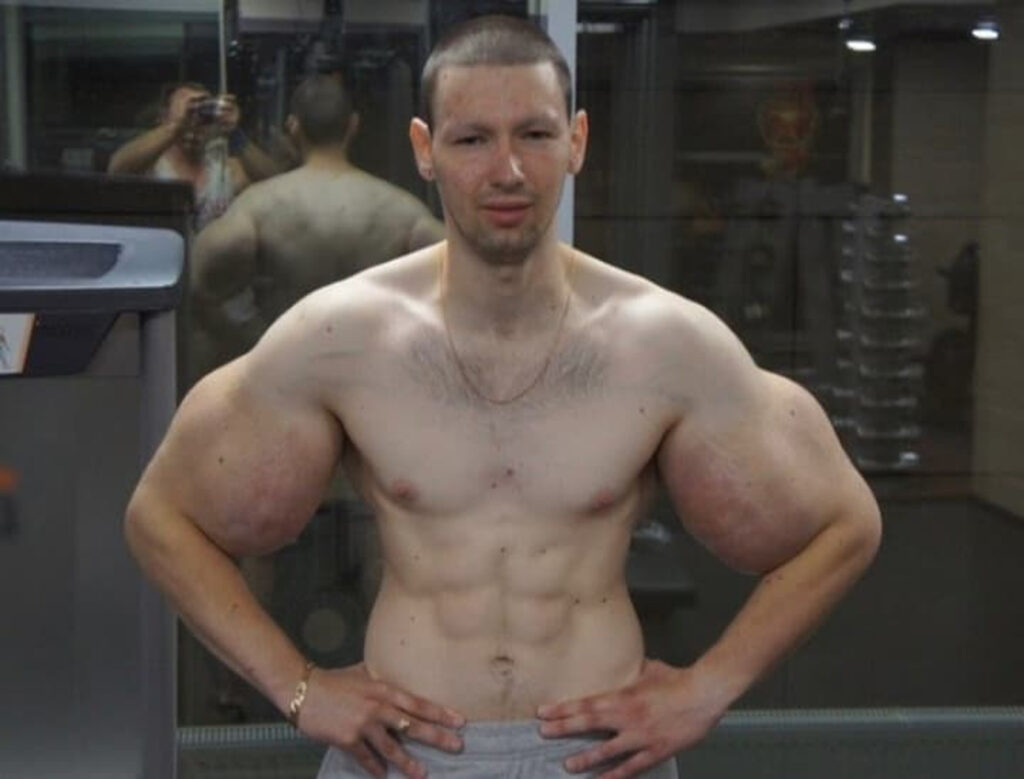Want big arms? I’m going to be brutally honest; have you ever seen many guys with massive arms and small pecs and lats?
What about vice versa — puny arms and massive wings?
I’m not saying they don’t exist, but they’re definitely in an extreme minority.
Moreover, you don’t wanna be one of those guys injecting synthol — like our friend in the thumbnail — and looking like a balloon animal. Not only is that sh*t unsightly, but it’s also unsanitary AF, and, not to mention, DANGEROUS.
How many guys at the gym do you see benching or rowing 315lb for reps have small arms?
Probably none, if any.
For a lot of newbies, however, some think that the way to big arms is to do 8-hour arm workouts. Dudes that do that on the internet are enhanced and have years of experience, and probably cut corners to get more views.
Please, for the love of God, don’t do an 8-hour arm workout.
And why the body is capable of a lot — naturally — building big arms will become a tougher task than needs be by prioritizing isolation exercises.
Compound Lifts for Big Arms?

A compound lift is an exercise movement that requires 2 or more joints and multiple muscle contractions to complete.
Examples of compound movement are the bench press, barbell row, overhead press, and pullup.
In my opinion, the best compound movements for big arms are for:
Biceps:
Barbell Row
Weighted Chin up
Seal Row
Triceps:
Weighted Dips
Banded Close-Grip Bench Press
Overhead Press
Progressive Overload
It’s harder to progressive overload on isolation work for arms.
Think about it: how much total weight can you add to your dumbbell row vis-a-vis your hammer curl. People with big arms can probably do both for a lot.
Few can hammer curl 100lb dumbbells with strict form, while many can dumbbell row 100lb for 10+ reps.
Although your bicep isn’t directly targeted, per se, as the muscle is partially contracted at the top of the movement; it is indirectly targeted and contributing towards lifting a weightload it may not be capable of doing in isolation — nobody can curl more than they can row.
A progressive overload schema is easier to follow with compound movements as increments in percentages are smaller in relation to isolation work. By this, a jump in a dumbbell row, as an example, from 100lb to 120lb is a 20% gain, and, for hammer curls, 50lb to 55lb in the below illustration is a 10% gain.
For Example for Big Arms
Week 1
Dumbbell Row 100lb 3×10
Hammer Curl 50lb 3×10
Week 4
Dumbbell Row 110lb 3×10
Hammer Curl 50lb 3×12
Week 10
Dumbbell Row 120lb 3×10
Hammer Curl 55lb 3×10
Take with a pinch of salt!
Handle Heavier Loads
The possibility for progressive overload increases at a faster rate than with just isolation movements.
Moreover, in a previous post, I have shown how, after reaching one’s genetic limit for muscle growth, a lifter can continue to get stronger.
Getting stronger on compound lifts will also translate to heavier working loads on isolation exercises.
In my experience, I could do tricep pressdowns with significantly greater loads after increasing my bench press.
I’m not saying you shouldn’t neglect isolation work — it matters. Isolation work is absolutely necessary for mind-muscle connection, directly targeting the muscle, and correcting any potential mechanical imbalances brought about by compound movements.
Isolation work is the cherry on top of your compound movements.
This is why many gym bros opt for splits such as chest and triceps, back and biceps, or shoulders and arms. The compound movements pre-exhaust the arms and the isolation work takes it over the edge.
A relatively uncommon split I used to like when I was younger was chest and biceps followed by back and triceps on another day. I would be training the antagonizing arm muscles as a way to add increased training stimulus to what I believed to be a lagging body part — my arms.
I, personally, found that targeting the arms directly after focusing on a major muscle group would overtrain them, and my body responded better to less volume, but more frequency.
As a natural lifter, you should seek to train with higher frequency but lower immediate volume (spreading total volume throughout the week). You can hit each upper body part 2-3 times a week if you split your volume wisely.
And your isolation work should strive to hit every major head in the arm and incorporating a variety of movements with differing strength curves according to your mechanical weaknesses. For example, with cables, the strength curve emphasizes greatest resistance near the beginning over the movement; whereas, with free weights, the strength curve peaks near the middle of the movement.
Further reading:
Don’t hesitate to email us at [email protected] for personalized coaching and a client questionnaire if you’d like DEDICATED tailor-made personal training on strength training, building muscle, losing fat, developing athleticism, and more — all to your liking, lifestyle, habits, and taste!
Otherwise, don’t forget to claim your FREE eBook detailing how to lose 20lb of fat while building muscle in 12 weeks! You can claim it here.











